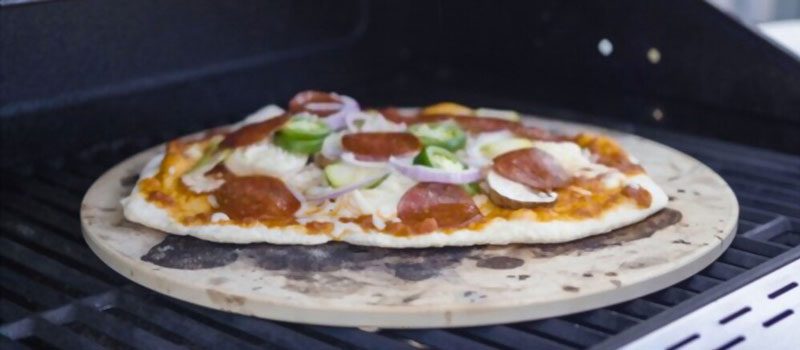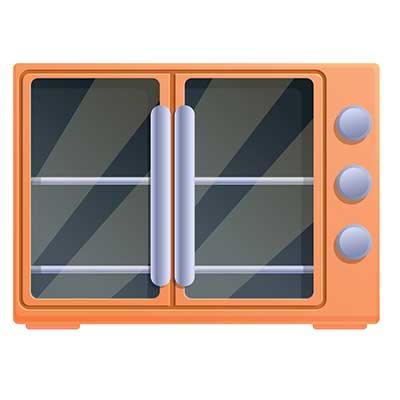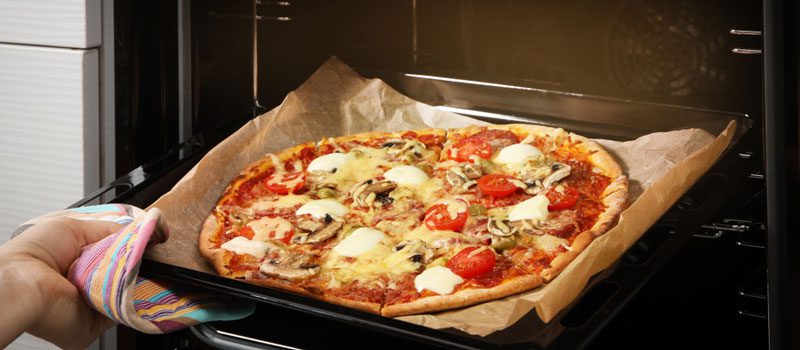A lot of pizza-making lovers often ask me, “Can I cook pizza on parchment paper?” While it’s touted to help prevent your pizza from sticking to the pizza stone, using parchment can ruin your pizza and be dangerous.

It’s not safe to use parchment paper to cook your pizza on a pizza stone, as most types of parchment are not designed to handle extreme temperatures. To achieve a crispier pizza crust on a baking stone, the oven needs to get up to 450 – 500 degrees F. Parchment paper tends to burn at this temperature range since the maximum temperature it can handle is about 430 degrees F.
In this post, we’ll discuss:
- Why it’s not safe to use parchment paper on a pizza stone
- Why a parchment paper is not a suitable choice for making a crispy crust
- How to keep your pizza from sticking to the pizza stone
- How to transfer your pizza without using a parchment paper
Why is Parchment Paper Used on a Pizza Stone?
A lot of people bake pizza using parchment paper on their pizza stones. This way does not guarantee a great pizza. Fortunately, there are other ways to achieve excellent results.
The main issue most pizza-making lovers are faced with is how to quickly transfer their pizza in and out of the oven and retrieve the dough from the pizza stone without a sweat (easy food release). Thus, it always seems like using parchment paper is an appropriate choice.
Why You Shouldn’t use Parchment Paper on a Pizza Stone?
Parchment papers are designed to handle high temperatures, but the temperature required to achieve a crispy pizza crust can be extreme, and most types of parchment paper won’t be able to withstand it.
Isn’t it possible to lower the baking temperature to safe limits?
Baking pizza on a pizza stone
There are many methods to bake your pizza, and one of them, arguably the best for home bakers, is a pizza stone. This baking tool helps turn your home kitchen oven into a proper pizza oven.

The main difference between a pizza oven and your kitchen oven is that the former can easily attain extreme temperatures. Its floor can get very hot to bake the pizza base for a crispier crust.
High heat is needed!
Pizza ovens are usually much hotter than the standard kitchen oven. A wood-fired Neapolitan pizza oven offers a temperature as high as 900 degrees F while the professional version max at 800 degrees F.
But the real question here is why high heat is needed for baking pizza in an oven. It’s pretty simple – consistency. You can quickly get crispy results on the outside at these extreme temperatures, while it’s nice and soft on the inside.
What happens if you bake at a lower temperature and for longer? The pizza gets dry without the crispy results. Also, the toppings, including the cheese, might get burned if left for a more extended period.
The oven floor
Another difference between the home convection ovens and pizza oven is the floor gets much hotter to guarantee a crispier crust.

This is where your pizza stone or baking sheet comes in handy. Pizza stone has excellent heat retention and gets really hot, which helps bake the pizza base for a crispier result. So, to get the expected ends, you need an oven that gets extremely hot.
Also, you want to preheat the stone for about an hour. This baking tool is similar to your cast iron skillet; it takes a while to heat up and retains the heat to ensure your pizza bakes evenly.
When to use Parchment Paper?
Most types of parchment paper are safe to use up to 420 degrees F. However, some models can withstand heat up to 430 degrees F. It’s best to cook pizza on parchment paper without exceeding the recommended temperature. Keep in mind that you might have a soggy pizza crust since you’re cooking at a low temperature and probably for a longer period.

What Happens When Parchment Paper is Used on a Pizza Stone
At temperatures beyond 430 degrees F, parchment paper will likely burn and turn into black ashes from personal experience.
How to Cook Pizza on Pizza Stone Without Parchment Paper
Now that we’ve established why it’s not advisable to cook pizza on a pizza stone with parchment paper. Let’s talk about how to bake pizza without sticking to the stone.
High heat
The main reason for having your pizza stick to the stone is that the tool was never properly preheated. A hot pizza stone will not only offer a crispy result but also guarantee a hassle-free food release.
Therefore, it’s best to keep the pizza stone in the oven for about an hour at the highest temperature setting to ensure it gets really hot before placing the dough. Leave the pizza on the stone without trying to move or turn the pizza for the best result. For a thin pizza crust, this should take about 5 – 8 mins.
Pizza crust thickness
If you want to bake Neapolitan pizza, you want to make sure the pizza is not too thin. The dough should be thin, but not too thin – it’s easier for sauce moisture to be absorbed by the super-thin pizza crust. Hence, you don’t get that crispy outcome.
Fewer toppings
Adding too much cheese, sauce, and toppings makes your pizza very soggy. Less topping means less liquid being added to the dough. This translates to quicker baking time, less moisture to vaporize, and high chance of getting crispy crust without a sticking experience.
Conclusion
By now, you should have figured out that parchment paper is only heat resistant up to 430 degrees F, which means you can cook pizza with it provided you stay within the safe limit.
However, the downside is you won’t be getting that preferred crispy crust and probably ruin your pizza. Nonetheless, you can still cook your favorite pizza on a pizza stone without using parchment paper.
All you have to do is appropriately preheat the pizza stone and use fewer toppings to get the desired results with a sticky experience. Keep in mind that the same holds for cooking pizza on parchment paper using baking steel.
